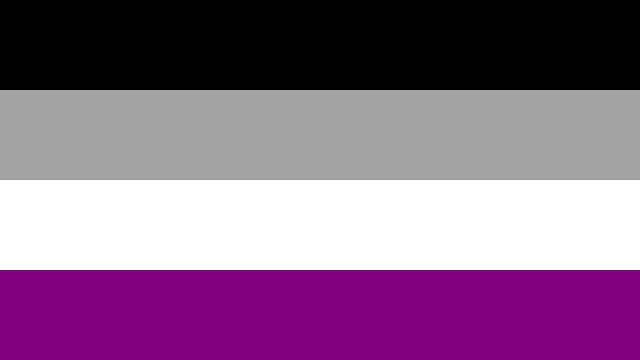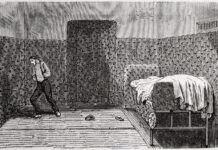“We live in a sex-normativity scenario incapable of challenging clichéd phrases like ‘sex is health.'”
~Vivyane Garbelini, “Asexuality: Recognizing the Invisible”

Prejudice is inseparable from the roots of psychiatry. If a diagnosis is an avenue in which the world can perceive a “sick mind,” an “illness,” then this means all with a mind are dictated by the psychiatric system’s threshold: every behavior, every thought, every action. The psychiatric system decides whether or not you can trust yourself or if anyone can trust you. The psychiatric system decides what communities of people are deserving of socioeconomic exile, isolation, and physical detainment. The psychiatric system’s roots and origins are of white, cisgender, heterosexual, Christian men supporting the maintenance of dictatorship for this group of people and this group of people alone. All others under its traumatic widespread prejudice are conditioned to live as a form of sub-humanity and/or object. The entire history of psychiatry stands on proving the intellectual inferiority of black people, women, and queer people.
Benjamin Rush, the father of modern psychiatry, created the diagnosis of “negritude,” claiming that all black people inherited this “disease” and declaring that “the color and figure of negroes is derived from what is known as leprosy,” which was used as the reason why black people were “inferior.” This diagnosis was used to justify segregation and slavery for many years to come. Hysteria, a once pervasive diagnosis, was thought to be “an exclusively female disease.” Women’s sexual thoughts were considered a “symptom” of this disease that could be “cured” by either sex or sexual abstinence. Pelvic massages, vibrators and even physically hosing women down with water were considered forms of “treatment.” Hysteria and all of its evolutions didn’t come to an end till 1980. Homosexuality has also been categorized as various disorders, and numerous mental health professionals have attempted to “treat” it. For example, David Matheson, a licensed professional counselor, created a version of conversion therapy specifically for men called “gender wholeness therapy,” which focused on men addressing emotional issues and building relationships with other men in an effort to reduce “homosexual desire.” These lists go on and on; trans communities have been given diagnoses such as “transsexualism,” “gender identity disorder,” “gender dysphoria,” “transvestic fetishism,” and “transvestic disorder.” As we delve further into this critical analysis of the sexualized roots of prejudice in psychiatry, we find asexual people are being misinformed and misunderstood as well.
An asexual person could be diagnosed with “Male or Female Hypoactive Sexual Desire Disorder” under the list of “Sexual Dysfunctions” in the 5th edition of the American Psychiatric Association’s Diagnostic and Statistical Manual of Mental Disorders.1 These diagnoses are used to pathologize asexuality. In recent years, revisions have been made to these two diagnoses to address asexuality and make an exception for people who identify as asexual. However, these revisions do not remove the DSM’s inherent prejudice against asexual people and may further contribute to their marginalization and pathologization. The Manual specifically states:
“Distress may be experienced as a result of the lack of sexual interest/arousal or as a result of significant interference in a woman’s life and well-being. If a lifelong lack of sexual desire is better explained by one’s self-identification as ‘asexual,’ then a diagnosis of female sexual interest/arousal disorder would not be made.” – American Psychiatric Association, Diagnostic and Statistical Manual of Mental Disorders.
“The presence of another sexual dysfunction does not rule out a diagnosis of male hypoactive sexual desire disorder, there is some evidence that up to one-half of men with low sexual desire also have erectile difficulties, and slightly fewer may also have early ejaculation difficulties. If the man’s low desire is explained by self-identification as an asexual, then the diagnosis of male hypoactive sexual desire disorder is not made.” – American Psychiatric Association, Diagnostic and Statistical Manual of Mental Disorders.
There are a few issues with these descriptions. First, the quotation marks around “asexuality” serve to delegitimize asexuality as a valid sexual orientation and identity. Second, the DSM requires a person to self-identify as asexual in order to not receive a diagnosis of Male or Female Hypoactive Sexual Desire Disorder. However, what if a person doesn’t know what asexuality is? A person may be asexual but still be diagnosed with Male or Female Hypoactive Sexual Desire Disorder if they have not heard of the term “asexual” or done enough research to understand what this identification means.
The final issue with these revisions is the requirement that there must be “clinically significant distress” observed in order to diagnose someone. The problem is that being told something is wrong with you repeatedly by society and those around you can lead to this described “clinically significant distress.” It is very difficult, if not impossible, for a clinician to distinguish whether a person’s distress is inherently caused by their lack of sexual interest/arousal, or rather by societal prejudice and bigotry against people with a lack of sexual interest/arousal.
After all, how could an asexual person not experience distress as a result of living in our oppressive society? Our society is that of a hypersexualized culture. If you are a person who is not interested in having sex because you do not experience varying levels of attraction, or if your varying levels of attraction differ — for example, if you do not experience sexual attraction but do experience romantic attraction, or if you experience sexual attraction infrequently and/or romantic attraction frequently — you are called a “prude who doesn’t know what you’re missing” or you are just plain “dysfunctional.”
I once was part of an asexual online group, where a gay man managed to comment on a group post wishing a sexual assault on an asexual person in the group, so this person could discover “how good sex actually is.” I was shocked initially and then recalled how many layers of privileges and injustices are present in our society. Our education systems and media as a whole have never respected or supported the representation of lived experience. For example, in the human services field, we have people educating others without having lived experience of the issues they claim to be experts on, all while failing to acknowledge all of the intersectionalities of the human experience. In the media, we have coded sexualization and under-representation of marginalized groups of people. The media represents not those with lived experience but those who are white, cisgender, and heterosexual; it perpetuates sex-normativity for people not within marginalized groups. What occurs both in education and media is misinformation, perpetuation of prejudice, and biases in favor of those with the most privilege.
The problem with the DSM, and especially the criterion of “clinically significant distress,” is that it not only pathologizes asexuality, but also pathologizes the distress asexual people feel due to marginalization and prejudice. In automatically attributing people’s distress to their lack of sexual attraction or interest, rather than their environment, psychiatry fails to recognize oppression and in turn perpetuates systemic biases.
It’s time we stop the objectification inherent within the psychiatric system and society. It is time that we stop feeling the need to comment or base our judgements on the way people experience not only their attraction but also their gender, race, ethnicity, nationality, and culture. The way in which we experience trauma, community, attraction, gender, race, ethnicity, nationality and culture etc. are crucial for us all to think about as often as we can. We are not defined by how we are assigned or labelled. Human experiences should not be viewed “dysfunctions” or something “wrong” with someone, but instead exactly as they are — natural. We need to think about how the language we use and our actions affect others. Above all, it is time to use our lived experience to create a more trauma-informed, culturally responsive mental health system and society.















Asexuality statistics, by asexuality.org:
https://asexualcensus.files.wordpress.com/2017/10/2015_ace_census_summary_report.pdf
Gender-ratio:
Asexual, gray-aexual, demisexual, etc. (n = 8,663)
female 56.8%
Not listed 30.9%
male 12.3%
There is no sex-ratio.
However, it is reasonable to assume that ~75% of asexuals are women, even if their gender is not necessarily female.
Report comment
The psychiatric system’s roots and origins are of [*] white, cisgender, heterosexual, Christian men supporting the maintenance of dictatorship for this group of people and this group of people alone.
*rich
Report comment
This is too timely not to share:
“On Contact: The Failings of the American Left with Charles Derber” [discussion of intersectionality and the politics of identity and priviilege when divorced from any critique of capitalism] https://www.youtube.com/watch?v=2C4aCCihy7s
Report comment
Comment removed for moderation
Report comment
So everyone’s sexual identity is a choice, eh? When, exactly, did you choose to be hetero?
Report comment
Ah man, I didn’t mean it in the way you’re implying. Maybe “choosing” was the wrong word? I have no problem if you ARE homosexual, heterosexual or transgender. Is that better?
See, this is the thing. I tried wording the thing in order to be as understanding as possible, and it’s still such a touchy subject, which is why it is fearsome to even write anything about it. One wrong word or comment can bring hell on to you.
Report comment
No hell intended, just an invitation to reflected on the meaning in the words. it is an entirely different message to say “choose to be” vs. saying “are.” When it comes to inherent traits, the choice we make is whether we will acknowledge and accept them- in ourselves as well as others.
Report comment
You could probably say both “we choose to be who we are,” and “we are who we choose to be,” up to a certain point at least. I don’t know if it can be definitively determined whether various traits and preferences are “inherent” or the product of experience, or both, but I don’t think it matters. “If it feels good do it.”
Report comment
Being lesbian, gay, bi, trans, etc., is not a “lifestyle choice.” The reality is that LGBT+ people are a product of nature’s diversity. It’s a common strategy of anti-LGBT+ activists to mislead people into thinking otherwise. That’s what makes this a political issue.
Report comment
Yes but some gay people “choose” to repress or closet their feelings, and some “choose” not to. Plus even if someone DID “choose” to be gay why would that be considered a bad thing? Sometimes obsession with semantics has the effect of shutting down the larger discussion. (This should not be interpreted as me “commenting on moderation” btw, I am speaking generally.)
Report comment
Comment removed for moderation
Report comment
Comment removed for moderation
Report comment
It might be that you didn’t intend it to be offensive, but it was anyway. You might take this opportunity to learn instead of whining about being moderated. Your comment was offensive in several ways, in addition to being completely off-topic.
Report comment
Vesper, certainly Psychiatry, Psychoanalysis, Psychotherapy, and the Recovery Movement, are horrid developments and we should oppose or abolish them. If you are hearing negative things from any of these sourced, terminate that connection. If you have any kind of a connection to any of these sources, terminate that connection.
I want to point out though that one of the original reasons for the popularity of Freud and Psychoanalysis is that as opposed to religion, it seemed to accept sexuality and a more animal sourced view of humanity. So people took to it.
Now today the world is very different. But I’m going to refrain from making any further comment on your thesis.
As Psychoanalysis was more open to human sexuality than religion was, it also is predicated on religion’s theory of Original Sin, some innate defect.
And so today, Psychiatry, Psychoanalysis, Psychotherapy, and the Recovery Movement are all designed to teach passivity and self loathing in the face of an unjust and abusive world. We need to act to put a stop to these things as best we can. Can’t really outlaw voluntary stupidity, but there are still things which can be done.
A Work In Progress
https://sites.google.com/site/stompingthecockroach/
Report comment
why take swings at the DSM without understanding who wrote it and why? the Mad In America folks don’t understand there’s something called Medical Intelligence in this country. Medical Intelligence is a gruesome black world underground cult of the medical establishment that has invented or keeps secret many bioweapons. They run the businesses, hospitals, military, universities and colleges in secret. They otherwise are known to have done manhattan project, mkultra, project star gate, obamas brain initiative, etc. they are literally on the level of Resident Evil powers and actually beyond it. they keep all their weapons secret much like the Manhattan Project in fact more secret than that. they never ever show how they can turn a human being into an actual zombie that spits blood at the mouth and which survives bullet shots.
in order to understand what the DSM is- one has to study this covert black world. many have already. psychiatry has always been a weapon of mass obidience to the world and what I am saying is: they know for a fact the conditions in the DSM are a lie and don’t exist inside of the people receiving diagnosis. they have done this level of fraud many times. believe it or not, all public education is controlled and crafted and before the public receives it they take out the stuff they don’t want the public to know or what may not be obvious to their brain. they insert various lies. they have actually at times crafted entire sciences that are made up in the public realm, but have many secret classified components kept hidden that explain how it really works such. an example very public of how this was done is parapsychology. back in the 1970s they used to have a lot of psychics running around but all of the sudden the core psychics just disappeared. they had the ability to read thoughts and control the environment using satellites and radar. the public was never told about the satellites and radar enabling it. the public science said these people had super natural powers. it was an obvious lie. the DOD, DIA, NSA, FBI and CIA crafted every material for the public to be lied to about it.
well then there’s the DSM. guess what? the entire thing is a crafted lie. and it has nothing to do per say with industry profits. it has to do with their global domination strategy: their desire to control the population from subconsciously to conciously. well the idea is a psychiatrists can secretly work for the DOD or CIA, diagnose citizens to discredit them and authorize their lock up based on ficticious brain abnormalities they never have a medical scientific test to show which is part of the con, and to then subject the person to harmful biomedical weapons designed to kill and maim the individual. Come on it’s that straight forward. There are people in control of this world who want to make the populous who isn’t them drop dead. They want to be able to lock those individuals up. They want to discredit those people by having alleged doctors come in who never have to perform any medical test to verify what they are saying write up huge reports and testify against the individual in court.
that’s the entire purpose of the DSM and psychiatry.
not only that but there’s many other plots to kill us going on. from plots to gut healthcare, housing, welfare etc. there are different ideologies in power- in the Democrat ideology they favor doing all the same crime against citizens but sometimes to lesser degrees. they may believe in killing less citizens, putting more restrictions on liberty violating measures like psychiatry, having free healthcare and housing and welfare etc but they might not always be able to shut it all down by themselves. certain democrats are also pure evil themselves you got to look at each person and find out who they really are.
yes the true reason you find the DSM loaded with every part of humanity? they want to be able to diagnose any smuck in front of them to discredit them, restraint them of liberty by locking them up in mental hospitals and AOT, and they want to be able to bludgeon these people with deadly drug cocktails. I can confirm that the DSM-5 was designed to prescribe diagnosis receivers drugs and ECT without any protection from it. They now even recommend drugs for personality disorders for Christ sake. The thing is some of the diagnosis receivers are whistleblowers and poor people, diagnosed not because they have symptoms but because this plot is upon them. trumpsweapon.com
Report comment
Wow. Some of this sounds reaching.
Report comment
[Democrats] may believe in killing less citizens, putting more restrictions on liberty violating measures like psychiatry
Not really; they’re often worse, as I think more liberals tend to “believe in” psychiatry and support “more money for mental health.”
Report comment
I’m remembering a quote from Walden. Can’t give it word for word but Thoreau said if anyone was coming to “do him good” and he knew it he would get up and run! They were more dangerous than those that actively harm people.
Report comment
The mental health system is rooted in the bogus sciences of Social Darwinism and Eugenics.
Report comment